All Topics
- Alchemizing Music Concepts for Students
- Artist Spotlight
- artium gift card
- Artium Maestros
- Artium News
- buying guide
- Carnatic Music
- Devotional Music
- Editorials by Ananth Vaidyanathan
- Film Music
- Guitar
- Hindustani Classical Music
- Indian Classical Music
- Indian Folk Music
- Insights
- Instruments
- Karaoke Singing
- Keyboard
- Kids Music
- maestros
- Music Education
- Music for Kids
- Music Industry
- Music Instruments
- Music Legends
- Music Theory
- Music Therapy
- Piano
- piano guide
- Success Stories
- Tamil Film Music
- Telugu Film Music
- Time Theory
- Tools
- Uncategorized
- Vocal Singing
- Vocals
- western classical music
- western music
- Western vocal music
Exploring the Underpinnings of Taal in Music: The Silent Language of Indian Classical Music
Exploring the Underpinnings of Taal in Music: The Silent Language of Indian Classical Music

Table of Contents
Imagine stepping into a world where time itself dances. That’s what it’s like to begin understanding taal in music. It’s not just about keeping a beat; it’s like entering a vibrant story told through the rhythm of indian classical music. Think of it as the ancient architecture upon which the beautiful mansion of a raga is built. Each rhythmic cycle, each taal, has its unique character, flow, and way of breathing.
These aren’t just arbitrary patterns; they carry echoes of history, tradition, and even the very pulse of life. The way a taal unfolds, with its stressed and unstressed beats, intricate divisions and subdivisions, feels like a narrative. It can evoke anticipation, resolution, joy, or quiet contemplation.
Take, for instance, the 16-beat cycle called Teentaal. It’s one of the most common and foundational taals, and it feels like a perfectly balanced story with four equal parts.
Imagine four friends walking together, their steps in perfect sync.
Every group of steps begins with a gentle emphasis on the first, like a soft nod that marks the start of a new phase in their journey. That’s what Teentaal feels like. Its balanced rhythm gives a sense of steadiness, creating a strong foundation as the taal in music where melodies and improvisation can beautifully unfold.
Understanding this rhythmic story of Indian classical music allows us to appreciate its underpinnings.
Taal: The Rhythmic Foundation of Indian Classical Music
Taal in Indian classical music is like a Clock! The rhythmic cycle carries the melody along, keeping everything running in time. Every song/instrumental piece in Hindustani classical music follows a specific taal, just as a clock follows a fixed cycle of hours.
Each beat in the taal is like a tick on the clock, precise, predictable, and essential for keeping the rhythm steady.
Imagine a simple taal with four beats. It’s like watching the second hand of a clock move from 12 to 3 to 6 to 9 and again back to 12. You count – one, two, three, four- and then start again. Each beat marks a moment in time, a very calculated and measured moment. This steady repetition gives movement to the music, even when no actual drum is being played.
It creates a framework for the melody to breathe, stretch, and soar, always knowing where its home is.
Role of Tabla In Taal (Hindustani Classical Music)
Now, a human is using their hands to keep this rhythm. That’s what the tabla does! It’s like two drums that speak different rhythmic sounds. The musician taps and strokes them differently to create a sound pattern matching the taal’s flow. These patterns aren’t just random; they’re like the intricate currents and eddies within our river, adding beauty and complexity to the journey of the music. So, taal is the steady flow, and the tabla is the voice that brings its rhythm to life.
The instrument produces a rich variety of expressive sounds in the hands of a skilled tabla player. While countless nuances exist, a few commonly recognized syllables exist—like dhaa, ga, ge, ka, tin, dhin, tirikiTa, and more. These vocalized sounds are called bols, and by combining them in different ways, tabla players create intricate rhythmic patterns.
These patterns are known as taals, with well-known examples including:
- Teentaal
- Ektaal
- Dadra
- Kaharwa
- Jhaptaal
The term taal refers to individual rhythm cycles and the broader concept of rhythm in Hindustani classical music.
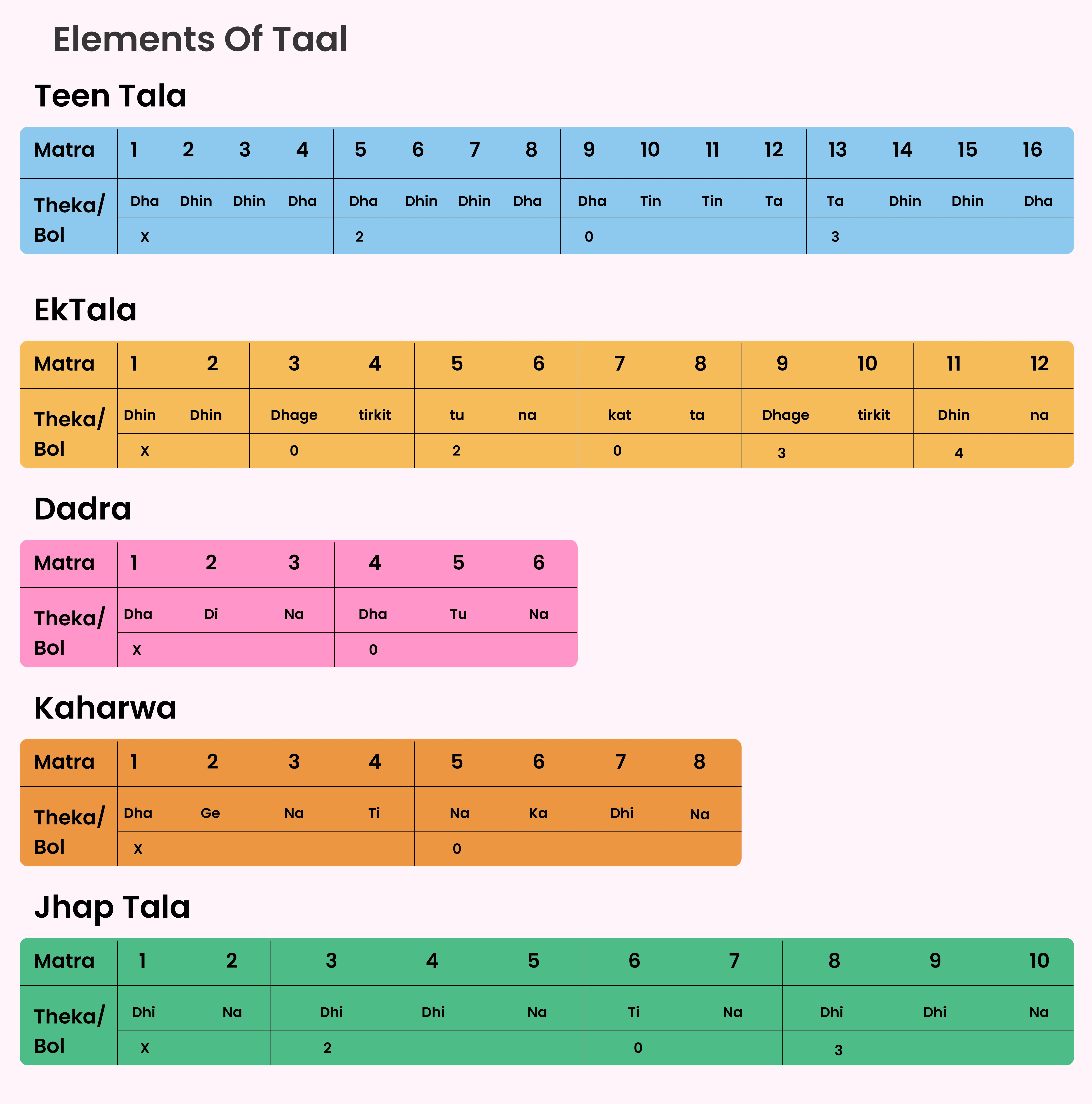
Concept of Taal: A Time-Turning Wheel (Carnatic Music)
Imagine a musical clock, where a set number of ticks (beats or matras) are grouped into smaller sections (angas). This repeating cycle (avartan) creates a journey of expectation and arrival, weaving layers of richness into the music.
Key Elements of Talam in Carnatic Music:
- Matra: The Heartbeat: The fundamental pulse of time in Hindustani music.
- Anga: Rhythmic Chapters: Divisions within the taal cycle, like verses in a story.
- Avartan: The Full Circle: The complete journey of the taal that continuously repeats.
Popular Talas in Carnatic Music
Carnatic music features a wide variety of talas, each with its own distinct structure and rhythm. Some of the most commonly used talas are:
- Adi Tala – A fundamental tala consisting of 8 beats (matras), typically structured as four plus two plus two (4+2+2).
- Rupaka Tala – A widely used tala with 3 beats, often divided as one plus two (1+2).
- Triputa Tala – A tala with 7 beats, generally structured as three plus two plus two (3+2+2).
- Jhampa Tala – A tala with 10 beats, commonly divided as a laghu (variable), an anudrutam (1 beat), and a drutam (2 beats).
Taal’s Guiding Hand in Hindustani & Carnatic Music
- The Rhythmic Bedrock: Taal provides the essential rhythmic foundation for every musical piece.
- Shaping the Melody: It subtly guides how the melody flows and is phrased.
- The Canvas for Creativity: Taal acts as the structure upon which improvisations and solo performances unfold.
- Defining the Musical Form: It dictates a composition’s overall architecture and progression.
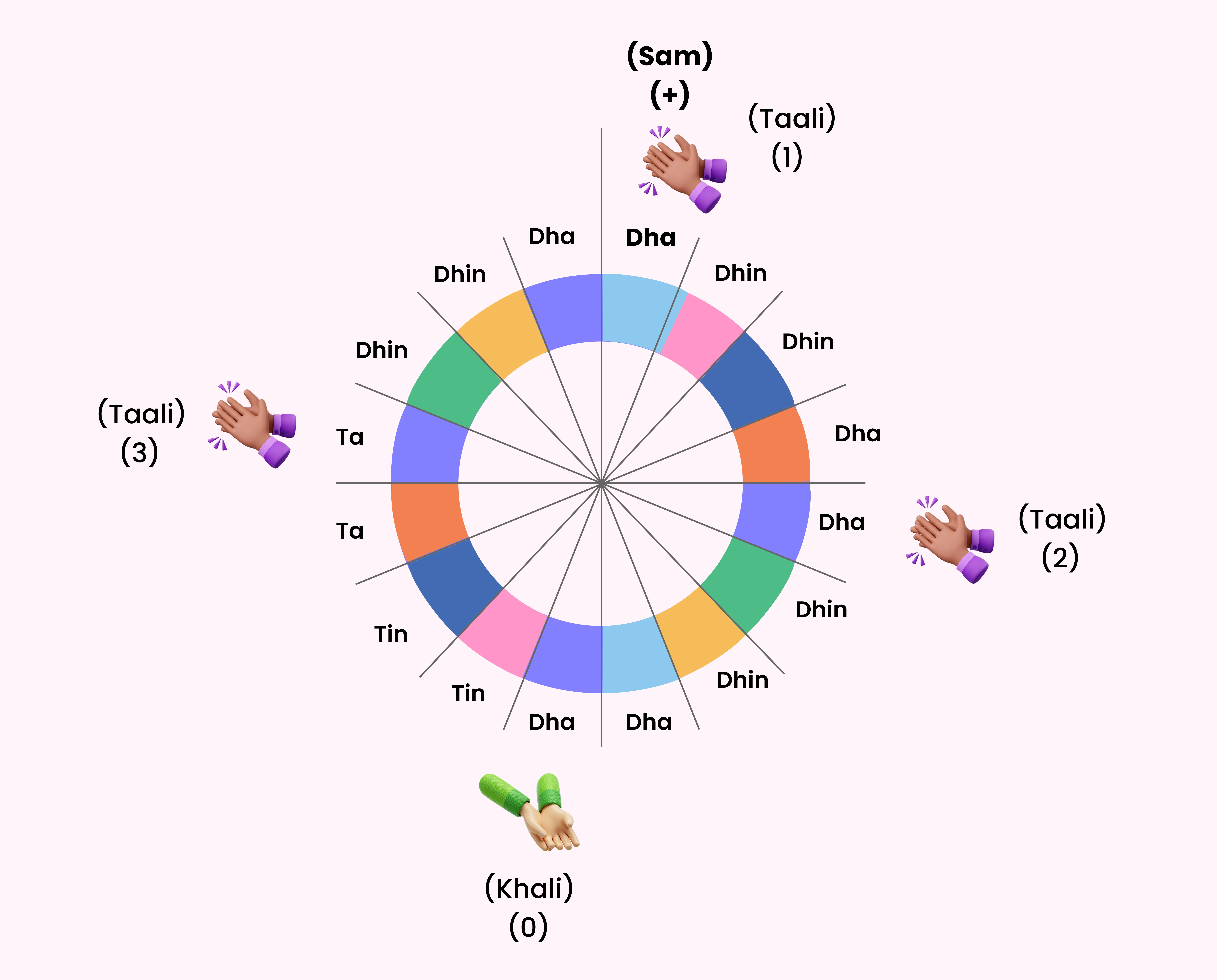
Exploring the Hidden Meaning of Taal in Music
Think of the rhythm in Indian classical music, taal, as more than a beat. It’s like a secret language woven into the music, where each cycle and number tells a story.
- The Circle of Time: Imagine a wheel that keeps turning – that’s what a taal is like. It’s a pattern of beats that repeats again and again. This circle reminds us of how time moves, like life with its beginnings and endings that always lead to something new, like the cycle of birth, death, and rebirth that many believe in.
- Numbers That Speak: The number of beats in a taal can also have a special meaning. For example, one very common Teentaal has 16 beats. This number feels complete and balanced, like everything is in its proper place. The way these beats play together, sometimes strong and sometimes gentle, can show how complicated and connected everything in life can be.
- Rhythm and the Soul: Some taals are used primarily for songs about gods and spirituality. These rhythms feel like a journey for your soul. For instance, Kaharwa is an 8-beat taal from the North Indian (Hindustani) tradition, commonly used in light classical music, bhajans, and Bollywood songs. It is not part of the South Indian (Carnatic) tala system, which features talams such as Adi, Rupakam, and others.
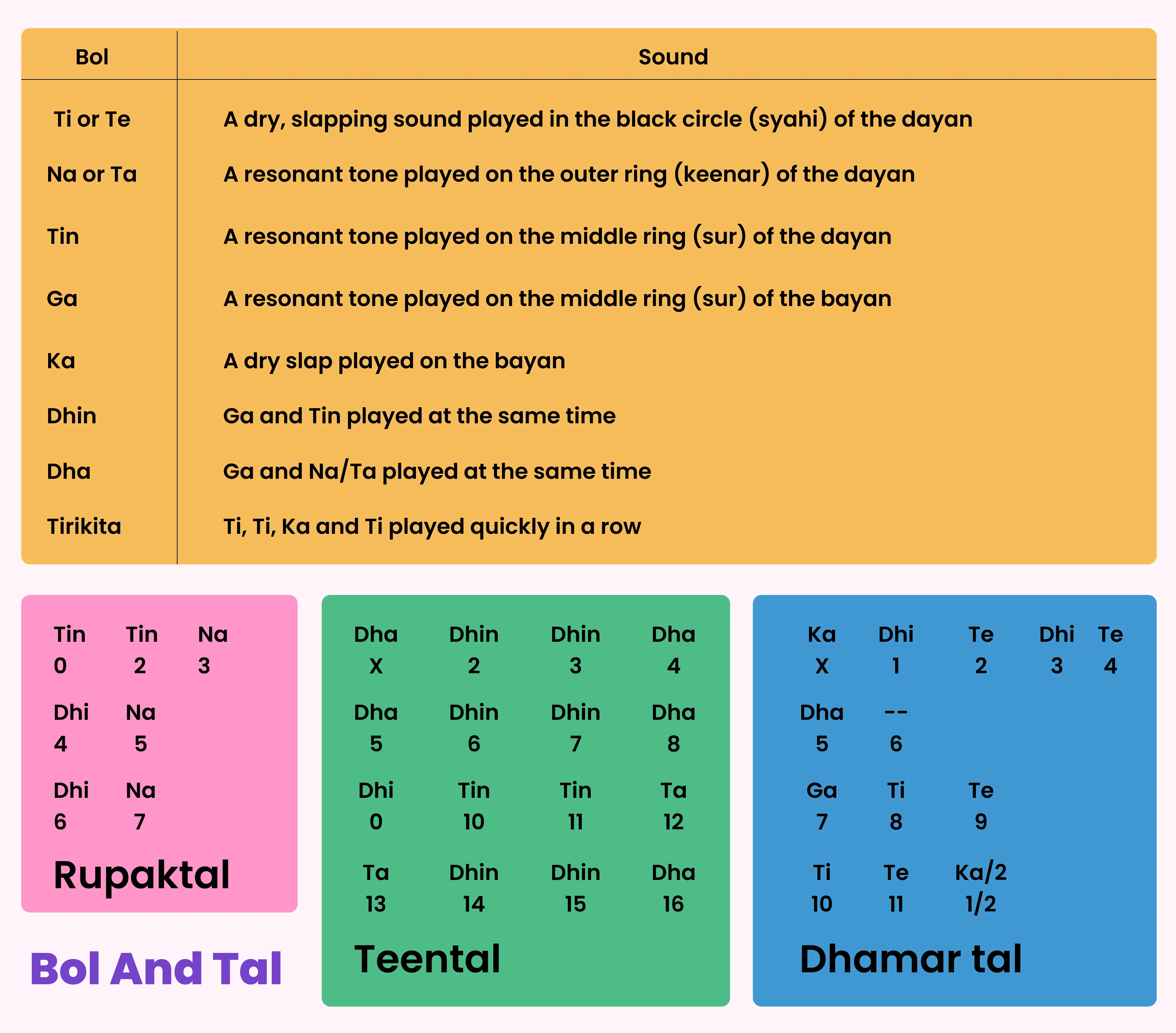
So, when you listen to the rhythm in Indian classical music, you’re not just hearing beats – you’re hearing stories about time, balance, and the journey of the spirit.
Navigating the 5 Challenges in Evolving Taal In Music
The exploration of taal in music within Indian classical music, encompassing both Hindustani classical music and its Carnatic counterpart, presents unique challenges and exciting opportunities. Maintaining the structural integrity and symbolic depth inherent in traditional taal in Indian classical music while fostering innovation requires a delicate balance.
Challenges include preserving the rich heritage of established taals, ensuring that rhythmic experimentation doesn’t dilute their essence. Rigorous training is also needed to equip musicians with the foundational understanding necessary for meaningful evolution.
While the evolution of taal in music within Indian Classical Music holds exciting possibilities, several significant challenges must be addressed to ensure meaningful progress without compromising the art form’s integrity.
What are the 7 Talas in Carnatic Music?
The 7 Talas, also known as Sapta Talas, form the rhythmic backbone of Carnatic classical music, offering structure and variety to compositions and improvisation.
- Dhruva Tala
- Matya Tala
- Rupaka Tala
- Jhampa Tala
- Triputa Tala
- Ata Tala
- Eka Tala
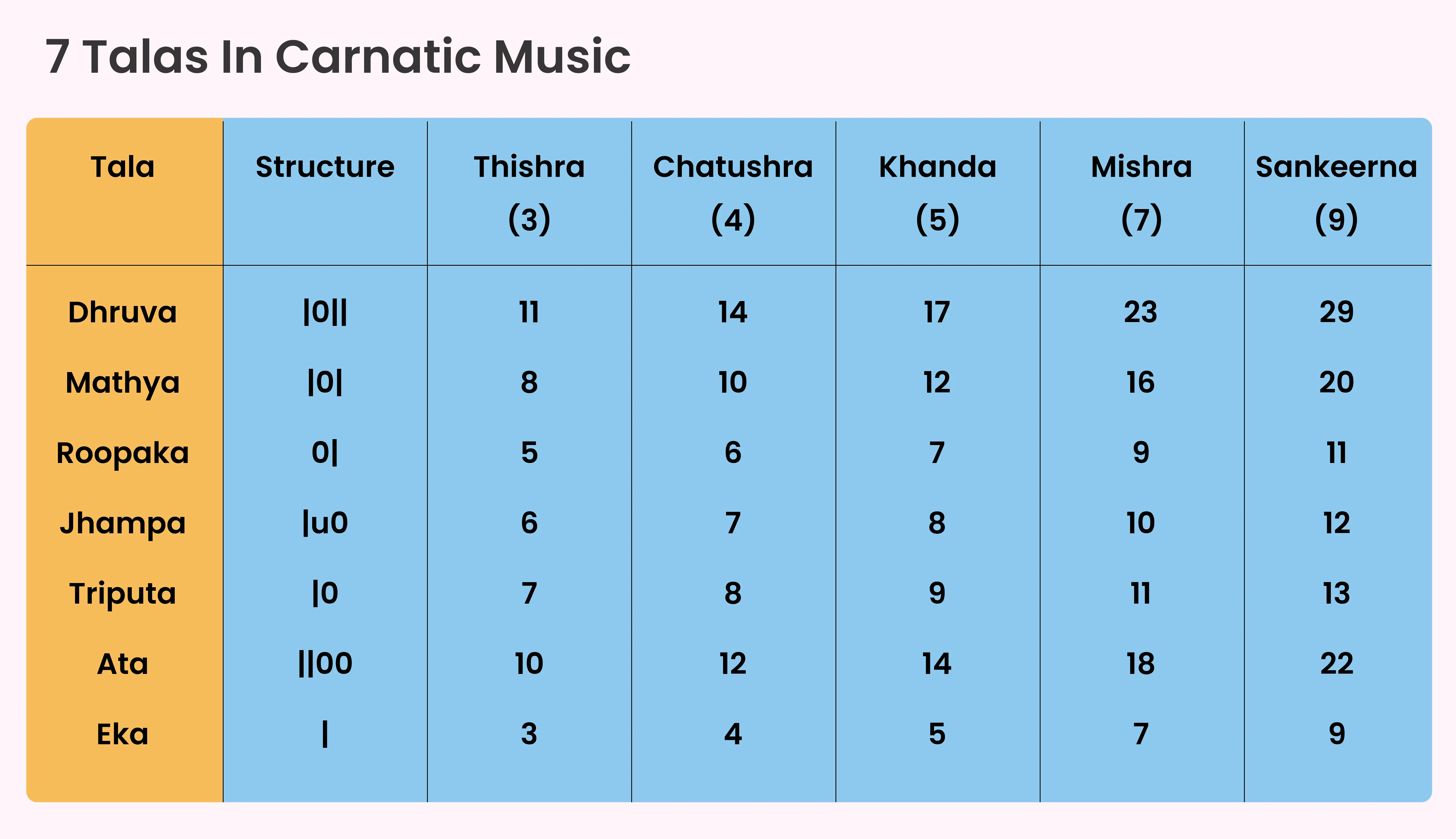
1. Preserving the Foundational Grammar
Each taal has a unique structure, specific beats, divisions (vibhags), and characteristic stress patterns (tali-khali). The primary challenge is ensuring that any experimentation remains rooted in a deep understanding of this foundational grammar. Without this grounding, innovations risk becoming superficial or distorting the inherent character and emotional resonance of the taal. Imagine trying to build a new sentence without understanding the basic rules of grammar – the meaning and impact would be lost.
2. Maintaining Symbolic Integrity
As discussed earlier, talas carry profound symbolic weight, representing cyclical time, balance, and spiritual journeys. Evolving taal requires sensitivity to these deeper meanings. Introducing complex or unconventional rhythmic patterns without considering their symbolic implications could inadvertently strip the music of its traditional and philosophical underpinnings. It’s like altering a sacred ritual without understanding its significance – the essence is diminished.
3. The Rigidity of Tradition and Training
Indian Classical Music places immense value on rigorous training and adherence to tradition. Introducing new rhythmic concepts can be met with resistance from purists who fear a dilution of the classical form. Furthermore, the existing pedagogical systems might not readily accommodate or effectively teach these evolving talas, creating a barrier for learners and teachers. Think of it as trying to teach a new language with only old textbooks – the learning process becomes challenging.
4. Ensuring Aesthetic Cohesion
The beauty of Indian Classical Music lies in the intricate relationship between melody (raga) and rhythm (taal). Evolving taal must always serve and enhance the melodic expression, not overshadow or clash. The challenge is to ensure that rhythmic innovations contribute to a richer aesthetic experience rather than creating a sense of disjointedness or rhythmic virtuosity for its own sake. It’s like adding a new color to a painting – it must harmonize with the existing palette to enhance the overall artwork.
5. The Risk of Superficial Fusion
The allure of cross-cultural collaborations can sometimes lead to superficial fusion, where rhythmic elements from different traditions are merely mixed without a genuine understanding of their respective contexts and nuances. This can result in a diluted and uninspired outcome that doesn’t truly honor either tradition. True evolution requires a deep and respectful engagement with different rhythmic systems.
Addressing these challenges requires a thoughtful and balanced approach. Musicians need to be both deeply knowledgeable about the classical framework and courageously creative in their explorations. A supportive ecosystem that encourages informed experimentation while valuing the preservation of tradition is crucial for the taal system in Indian Classical Music to evolve in a meaningful and enriching way.
However, the evolving landscape offers immense opportunities. Contemporary collaborations and technological advancements can inspire new rhythmic complexities and cross-cultural dialogues.
Musicians are exploring nuanced subdivisions and polyrhythms within the classical framework, enriching the expressive potential of taal. The key lies in approaching evolution with deep respect for tradition, allowing innovation to emerge organically from a profound understanding of the rhythmic principles that underpin classical Indian music. This ensures that taal remains a vibrant and dynamic element of Indian classical music for all generations.
New Rhythms, Ancient Roots: How Musicians are Playing with Taal?
Imagine the steady beat of taal in Indian Classical Music as a strong, ancient tree. Its roots are rooted in tradition, but its branches can reach the sky in new and surprising ways. Today, many musicians are like curious gardeners, experimenting with how these rhythmic branches can grow.
They’re playing with rhythmic cycles—the repeating patterns of taal—by making them more complex or even layering them on each other. Consider it multiple clocks ticking at different speeds, creating a fascinating interplay of time. This is called cross-rhythm, where different taals or parts of taals dance together.
Some artists also use unconventional approaches, using sounds and patterns you might not usually hear in classical music. They may incorporate influences from other music styles or use technology to create new rhythmic textures.
But here’s the important part: they’re still honouring the core principles of this ancient system. They understand the deep structure and feeling of the traditional taals. Their experiments aren’t about breaking the rules but finding new ways to express themselves within that rich framework. It’s like a painter using new colours and techniques but still understanding the fundamentals of drawing and composition.
This exciting exploration keeps taal in music alive and relevant, showing that even a centuries-old tradition can blossom with fresh ideas. It’s a testament to the enduring power of Indian Classical Music and the creativity of the musicians who continue to shape its future.
Story of Taal: Echoes of the Past, Rhythms of Tomorrow
The future of Taal in Indian classical music is vibrant, powered by thought and innovation. Musicians deeply rooted in tradition are now sonic architects, layering complex rhythms and exploring cross-cultural beats while honouring the timeless structure of Hindustani classical music.
Platforms like Artium Academy are democratizing this evolution. The hassle-free online Indian classical music classes, Hindustani music lessons, and online Carnatic music classes accredited by GRMP, opening the intricate world of taal to eager learners of all ages.
From the foundational taal in Indian classical music to the exciting frontiers of rhythmic experimentation, the journey is now accessible from anywhere.
The digital space becomes a fertile ground for preserving the core and nurturing the new, ensuring the world’s rhythmic heartbeat resonates globally for generations.
You can book a free Demo Lesson now!
Validated by Abhijeet Thakur (Hindustani Music Faculty) and Sidhi Subramanium (Carnatic Music Faculty) at Artium Academy
FAQs on Taal in Music
In Indian classical music, Taal (also spelled Tala in Carnatic music) is best understood as the rhythmic framework that organizes a musical composition. It’s much more than just a beat; it’s a cyclical system of timekeeping that provides structure and a foundation for the melody and any improvisations. Think of Taal as a rhythmic cycle with a specific number of beats (matras in Hindustani music, aksharas in Carnatic music) that are arranged into divisions (angas or vibhags). This cycle, called an avartan, repeats throughout a performance, creating a sense of rhythmic expectation and resolution.
Key aspects of Taal include:
-
- Cyclic Nature: The repeating pattern symbolizes the flow of time.
-
- Beats (Matras/Aksharas): The fundamental units of time.
-
- Divisions (Angas/Vibhags): Groupings of beats within the cycle.
-
- Stress Patterns: Some beats are emphasized (like the sam, the first beat of the cycle), while others might be unstressed (khali in Hindustani music).
-
- Hand Gestures: Traditionally, Taal is often counted and shown using hand claps, waves, and finger counts.
The concept of Taal encompasses various rhythmic cycles and structures within Indian classical music. While the fundamental principle of a repeating rhythmic framework remains consistent, the specific types and their characteristics differ majorly between the two main systems: Hindustani (North Indian) and Carnatic (South Indian).
Sur is the accurate pitch of musical notes, forming melodies. Taal is the rhythmic cycle, the structured beat pattern that organizes the music in time. Laya is the tempo or speed at which the taal and melody unfold.
These three fundamental elements—pitch, rhythm, and tempo—are inseparable and crucial to the essence and beauty of Indian classical music. Their harmonious interplay creates a complete and enriching musical experience.
Teen Taal, known as Teentaal, is among the most popular and widely used rhythmic cycles (taal) in Indian classical music, especially in Hindustani tradition. It consists of 16 beats divided into four equal sections of 4 beats each. “Teen” refers to the cycle’s third clap (tali). Teentaal provides a structured rhythmic foundation for compositions and improvisations in both vocal and instrumental performances.

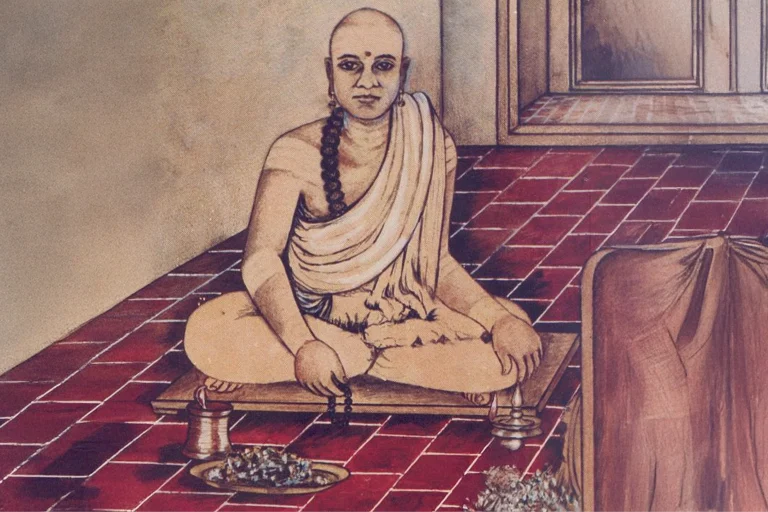
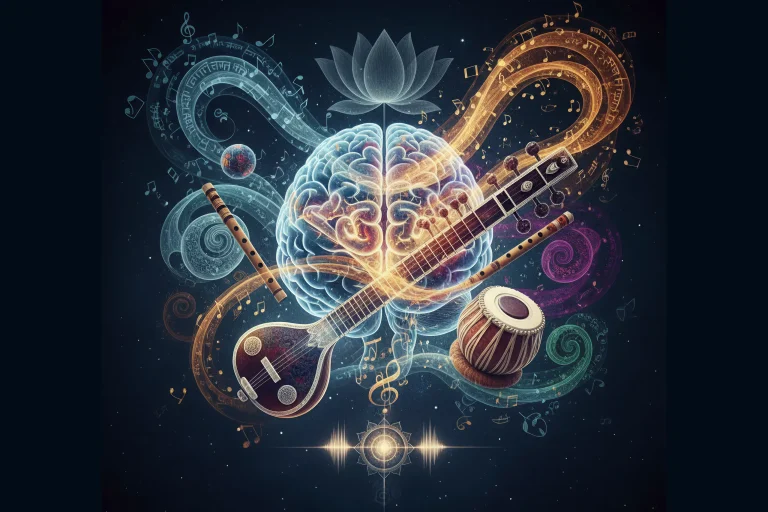
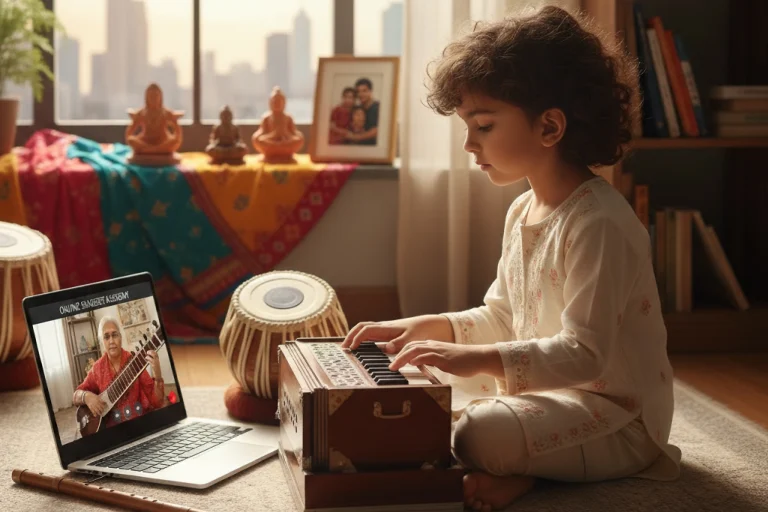
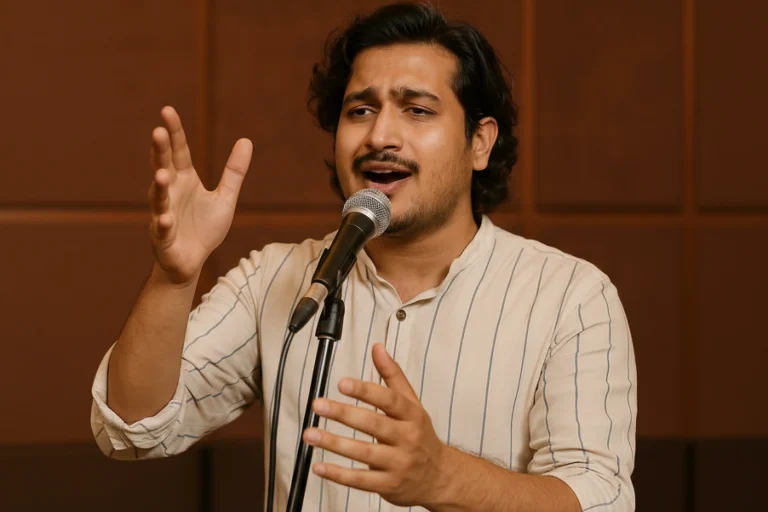
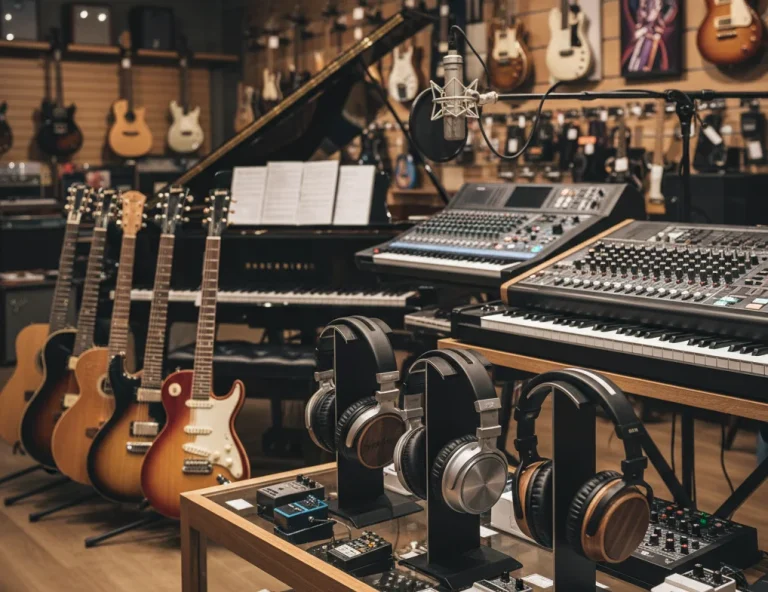

Wow! this was interesting to read, and the graphics made it easy to understand too